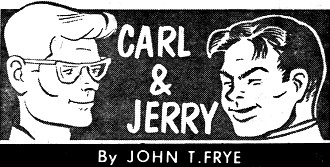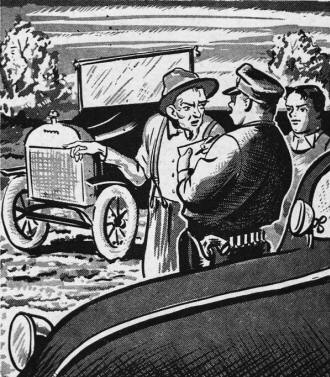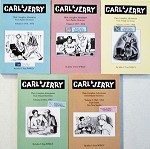Carl & Jerry: Abetting or Not?
|
|||||||
Carl and Jerry found the appearance and construction of 2,400 megacycle transmitters and receivers to be quite odd compared to the equipment they were used to dealing with. It's sometimes hard to believe such an attitude of wonder when our world today is utterly filled with wireless devices operating in the 2.4 GHz ISM band. Author John T. Frye could never have imagined that such a reality would would exist half a century after his story of the pair of teenage electronics sleuths. Unlike our postage stamp size integrated assemblies that cost a few dollars, they speak of "special ultra-high-frequency 'light-house' tubes with a cavity resonator clamped on top of them." Back to the story, though... Did you know that police were using radar guns as far back as 1963? Carl & Jerry: Abetting or Not?  By John T. Frye By John T. Frye
Carl and Jerry were preparing to go on one of their electronic safaris. Equipment to be taken along was spread out on the workbench of their basement laboratory, and Jerry was carefully dividing it into two piles. First he placed a 75-meter transceiver in each pile. These were followed by identical small dish-type reflector antennas and small collapsing tripod mounts to support them. Then he placed a small power supply in the pile next to him and a larger and much heavier combination power supply and modulator in the pile Carl was to carry . Finally, two small chassis, each carrying what seemed to be a weird-shaped bit of brass plumbing clamped around the top of a metal tube, were divided among the growing stacks of equipment. The two chassis were not exactly alike for, in addition to the unusual appearing tubes, one of them also had a conventional miniature glass tube mounted on it. "These things look like they'd suck eggs," was Carl's disparaging remark as he examined the unusual pieces of equipment. "I've seen some odd-ball transmitters and receivers in my day, but these things are ridiculous." "At 2400 megacycles, you can't expect conventional-looking transmitters and receivers," Jerry pointed out. "A wavelength at that frequency is only 12.5 centimeters long - or approximately 4.92 inches. Compare that with about 260 feet for a wavelength on 80 meters." "What are these things that look like tubes crossed with bathroom fixtures?" "Those are special ultra-high-frequency 'light-house' tubes with a cavity resonator clamped on top of them. The one-tube job is the transmitter, while the other is the receiver - a superregenerative type with a separately quenched oscillator. The transmitter only puts out a maximum of a quarter of a watt, but these reflector-type antennas should give us enough gain to cover that quarter mile between Uncle Walt's and his neighbor up the highway." "Why have we got to lug all this stuff clear out there? Why can't we just test it around here?" "Because that's the closest place I know of where we can get a clear shot across that distance with absolutely nothing in the way, and where we can have power for our rigs at both ends. Uncle Walt lives right on a curve in the highway, and you can look from his front porch straight up the pavement to Mr. Arthur's porch. I'll operate the transmitter at Uncle Walt's, and you can work the receiver at Mr. Arthur's." "What do we need the transceivers for, anyway?" "We'll probably have to do a lot of adjusting of antenna direction, frequency, etc., to get maximum signal strength. Since we'll only have one transmitter and one receiver on the ultra-high frequency, we can only talk one way after we establish contact. Being able to talk back and forth on seventy-five while making adjustments will help a lot." "Okay; so let's get going," Carl said; and he quickly exchanged the heavy power supply in his pile for the light one in Jerry's while the latter's back was turned. The two boys loaded the equipment into the handlebar baskets they strapped on their bicycles only for occasions like this, (Ordinarily such accessories were considered "too sissy.") Carried along by their youthful enthusiasm, it required but a few minutes for them to pedal out to the farm of Jerry's Uncle Walter Bishop. Carl helped Jerry set up the transmitter and connect it to the power supply and modulator. The little dish-type antenna and reflector was perched on its tripod, and a short coaxial line ran down to the output fitting on the side of the cavity resonator. Next, both boys rode on down the narrow path from the highway to Mr. Arthur's and set up the receiver on his porch. When Jerry was sure the receiver was working correctly, he took off the earphones and reached over and let them snap shut on Carl's head with a resounding "plop." "Guess we're ready," he announced. "Use a single phone over one ear and leave the other free for use with the transceiver. The instant you .hear my voice on the u.h.f. receiver, yell at me on the hand-held unit, for it, will mean that I have the transmitting antenna pointed nearly at you. That beam will be very narrow, and we'll have to aim it right on the nose. Once we make contact, we can go ahead and align both transmitter and receiver antennas perfectly, checking back and forth with the transceivers; and then you can carefully tune the receiver to the exact transmitter frequency." "I can?" Carl questioned sarcastically. "With what? I see nothing that looks like a tuning knob on this plumber's nightmare." "You tune the receiver by turning this little screw right here on top of the cavity resonator with this long fiber screwdriver," Jerry explained; "and move it only a fraction of a turn at a time." Having delivered this bit of advice, he hopped back on his bicycle and was soon at his uncle's place. After switching on the high-frequency transmitter, he pulled out the telescoping antenna of the war-surplus transceiver, which automatically turned it on. Holding the case so that the earphone was at his ear and the microphone in front of his lips, he pushed the transmit-receive switch covered with a waterproof rubber pouch on the side of the case. "How do you read, W9EGV? This is W9CFI," he said. "Loud and clear, W9CFI, from W9EGV," was the prompt answer. "Okay; I'm going to start shooting at you, If you hear me, yell plenty loud, for I'll have to set the handie-talkie down on the floor while I'm fiddling with the antenna." "Roger. Let's see if you can spray me with some of that u.h.f." Jerry began carefully aiming the reflector at the porch of the white house up the road. For several seconds nothing happened, and then he heard a faint cry from the earphone of the handle-talkie sitting beside him. "Hold it!" Carl said; you're knocking down the hiss in the receiver." "Can you hear me?" Jerry asked into the microphone connected to the modulator of the u.h.f. transmitter. "Sure can," came the answer; "Wups! You cut out for a minute, but it's okay again now." As Carl said this, Jerry noticed a large black car with two men in it pull off the highway onto the path just next to his uncle's house. It was when this car had passed through the u.h.f. beam that Carl said the signal cut out momentarily. Jerry concluded the men had stopped to examine a map or something, and he and .Carl went ahead with their experimenting. It was not until two more cars pulled up opposite the first one that Jerry took more careful notice. One of the cars that just stopped was an ancient Model A Ford truck loaded with late-in-the-season watermelons. The. driver was a little weazened man with a sharply-pointed white goatee; and from the way he popped from the cab and began waving his arms about, he was obviously quite excited about something. The unmistakable appearance of the other car, a state police patrol, gave a possible clue to the cause of his agitation. "Hey, Carl,"· Jerry said into the mike, "you'd better come on down here and see what gives. Looks like it may get interesting." Collapsing the antenna of the handle-talkie to shut it off, Jerry hurriedly left without thinking to shut off the u.h.f. transmitter. He had barely reached the parked cars before Carl came pumping up on his bicycle. "I tell you," the little man was shouting, "that you and your fancy radar gadget are all wrong. You can't possibly drive that bucket-of-bolts sixty-five." "Take it easy, Pop," the big state trooper behind the wheel of the black car said good-humoredly. "This thing doesn't make mistakes. It said you were hitting sixty-five when you passed, and that's what you were doing. So we radioed ahead for Jim to stop you." "You and your fancy radar gadget are all wrong," the man with the goatee was shouting. "You can't possibly drive that bucket-of-bolts sixty-five."
"Old Timer, you've got yourself a deal," the youthful trooper named Jim said, as he slid out of his patrol car. "I always did want to drive one of those old cars my old man still insists is 'the best car Henry ever built.' If you got sixty-five out of that iron, so can I. I'll go back up the road a piece and come on by with the thing wide open so you boys can get a reading on me." He got into the truck, and went off up the highway with the motor spluttering. Do you know how that radar thing works?" Carl whispered to Jerry. "Sure. So would you if you had read the article about it in the May, 1956, issue of Popular Electronics. It depends on the Doppler effect." "I remember that from physics. It's an apparent change in frequency of a signal emanating from a moving source as observed from a fixed position." "Fine," said Jerry. "That's exactly right. The most common example is the apparent change in the pitch of a train whistle as it passes. When it's coming toward you, the pitch seems to increase; but as the train moves away, the pitch lowers. When the train is moving rapidly toward you, the sound waves are sort of bunched together and the pitch of the signal striking the ear is increased. When the whistle is moving away, the sound waves are stretched out, and the pitch seems lower. The radar gadget sends out a beam of u.h.f. signal that strikes the moving car and is reflected back to a receiver housed in the same unit with the transmitter. "This reflected signal is mixed with the signal direct from the transmitter," Jerry continued, "and the difference between their frequencies is read by an audio frequency meter. The difference in frequency between the transmitted signal and the reflected signal depends directly on how fast the car reflecting the signal is moving. The faster it moves, the greater is the difference. At 100 miles per hour, the reflected signal will be shifted 731 cycles from the transmitter frequency of 2455 megacycles. Speeds below 100 miles per hour produce less shift. The audio frequency meter is calibrated in miles per hour for direct reading of speed." "But where is the radar gadget?" "Probably in the trunk of the black car. You can see the meter there on top of the dash. The signal is sent out and received back through a camouflaged hole in the metal lid of the trunk. All this car has to do is park along the highway and take speed readings. When a 'live prospect' shoots past, the radar car radios to a patrol car waiting about a mile down the highway, and he picks up the speeder. Well, here comes the truck; let's go over and see what kind of a reading it gives." The boys moved over to the black car and watched the meter on the dash as the truck went spluttering by. The pointer rose sluggishly to a reading of thirty-five miles per hour. "That's all that crate will do," Jim announced, as he drove back and parked the truck. "I had my foot clear down in the fan. My old man must have rocks in his head if he thinks that's a good car." "I don't get it," the radar operator behind the wheel said to the other. "This thing never was wrong before. I still say we give the old gentleman a ticket - hey!" he broke off, "look at the meter." Sure enough, the meter on the dash was jumping crazily about. Jerry's glance went from it to his Aunt Enid busily sweeping the immaculate front porch. (As every woman knows, a broom is a wonderful excuse for staying within earshot and eyesight of any interesting event!) As her broom nudged the coaxial cable, the dish antenna wobbled back and forth. "Watch that meter a moment while I do something up on the porch," Jerry suggested to the men in the car. Running to the u.h.f. transmitter, he swept the invisible beam from the antenna back and forth across the trunk of the black car. "That's what's doing it!" one of the men called. "What you got up there anyway?" Carl and Jerry explained that the transmitter they were using was supposed to be in the 2300-2450 mc. ham band, but, that since they had no extremely accurate frequency-measuring equipment at this frequency, the transmitter had drifted down very close to the 2455-mc. frequency of the radar transmitter. The difference in frequency was just enough to give a good reading on the speed indicator. "Well, that's one for the book," the man behind the wheel said, tearing up the speeding ticket he had started to write. "Of all the places we had to set up our operation, we had to pick this one directly in the path of your beam. Pop, I'm sorry for all the hard time we've given you." "That's all right; young man; we're all wrong at one time or another," the little man with the goatee said pleasantly; "but I feel I owe these boys a favor. How about giving you a lift back to town if you're ready to go? You can put your bikes in back." The boys promptly took him up on the offer, and soon they were chugging down the road. After they had gone about a mile, the little old man took a cautious look in his rear-view mirror, then reached over to the right side of the dash and gave a shiny knob there a practiced turn counterclockwise. Instantly the popping motor smoothed out and the truck plunged forward on the road. "These young whipper-snappers don't savvy a combination choke and carburetor control any more than a redskin used to savvy the hindsight on a rifle," the old fellow said with a cackling laugh. "Fact is, most of the young ones don't know what a hand-choke is, let alone a .dash-mounted carburetor control. When I saw that patrol car take out after me, I just leaned over and cut Betsy's gas down until she would barely run. That's why the officer could only get thirty-five out of her. Shucks, with her Fronty head and special camshaft, she'll hit seventy-five without a bit of trouble." Carl and Jerry made no comment. When the old man let them out at their homes, he insisted that each accept a large watermelon. As he drove off, Carl turned to his pal and said slowly: "Jer, I feel kind of funny. I'm not at all sure but that we helped defeat 'due process of law' today." "Neither am I. On the other hand, maybe our transmitter did get into the act. We'll never know. Let's go in and eat watermelon while we brood about it!"
Posted June 12, 2019 |
|||||||


 Carl & Jerry, by John T. Frye
Carl & Jerry, by John T. Frye